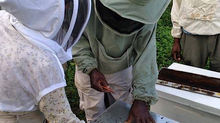Building Bridges with the “Better Living Through Chemistry” Generation
- Laura Bee
- May 1, 2013
- 7 min read
About a week ago I got a call from an older lady with a concern about some “bees that were biting my husband.” Apparently the “bees” lived in a tidy shrub in her yard and were getting defensive. I knew right away that we were talking about the Beekeeper’s number one emergency call: Wasps.
Bless her heart, Linda was concerned about the ‘bees’ and was also concerned about her husband whose job it is to care for the shrubs and manicured lawn. The elderly are at greater risk of serious reaction to multiple stings, so I thought I would head over and see if I could help them out. If I were really lucky, we would find ourselves with a hive of honeybees. This doesn’t happen as often as I ould like, butI always respond to these calls because they usually turn out to be an opportunity to educate and learn about our pollinators.
With our new intern Scott in tow, we drove into the shopping district and looked around for pollinator plants. I remarked bravely “After Bee City Talent and Ashland, we will make a Bee City Medford!” even while assessing the work necessary to restore the polluted, barren landscape and retelling a story of an honeybee hive-extraction at the Mall; While collecting the weak hive we noticed the bee’s wax and honey was grey and a brief scan of the environment confirmed that the traffic soot was most likely to blame. The story of the environment written right their in the bee’s nectar library! Heartbreaking! But we are intrepid beekeepers! We respond to distress calls!
The couple were ready at the door and excited to share their discovery with us. After a quick inspection of the box laurel hedge I saw a tidy dime sized hole in the ground at the base of the trunk. Yup, meat bees, yellow jackets, ground wasps. And a remarkably docile hive. There were no defensive behaviors and they were quite satisfied with their real estate.
Linda said something about “I like how respectful you are to them>” “
“Yes, we really should be, shouldn’t we!” I remarked optimistically, “I really love them, all of them!”
Yet, love aside, the problem remained. There was an underground wasp nest, within the roots of a lovingly manicured box laurel in the yard and neighborhood of elderly folks.
Removing ground nests is the most difficult of wasp eradication. This case would have involved digging up the hedge entirely, undoubtedly unleashing wasp-fury, all beyond my abilities to handle. One method, that escaped my mind at the time was to cap the hole with a clear glass bowl, burying the edges so there is no way for them to get out. This confuses the wasps and supposedly they do not dig new holes. If there is another entrance this will be for naught. But the placement of the entrance would not have allowed this as a method anyway.
If there is another way to remove the hive (neither drowning or burning a ground hive is a good solution: wasps will attack under these conditions) I did not know it at the time, though I will definitely try to learn and practice new methods.
When I stood the couple asked how to get rid of it. I told them I couldn’t recommend pesticides as it is basically against my religion and I suspect a professional would use them. And the gentle man popped into the garage and brought out a nearly empty can of wasp killer. I heaved an inward sigh. I knew what was coming next. They saw me as an expert, prepared and unafraid of this ‘invasion of dangerous insect.” I knew I could not convince them to co-habitate. The nest was right next to the front door. Stings can have more complications for the elderly. They will hire someone, or worse yet, this older man will take it upon himself to handle it. Oh, the moral dilemma of this moment. This was what they wanted, they wanted and needed the hive killed or removed somehow. I was here with a suit on, the situation could get ugly fast for these frail elders should they battle the situation themselves. I took the can from him nearly heaving with guilt.
“We really need to get you off of pesticides” I quailed. “I will do this for you, but this kills all the bugs, right?” The lady replied “I know! But you have to teach us!”
Recalling this I am tearful. So many are hearing the call of the pollinators, but we don’t know how to help them! I say ‘we’ because I live in an area with tens of thousands of people that don’t know the difference between a yellow jacket and a honey bee! But what makes me tearful is this woman, standing in her beautiful tidy corner of paradise, with her love for the honeybees enough that she sought to preserve them if possible, openly asked to learn about pesticdes and healthier gardening. While I stood there with a can of, oh, I don’t know…’Hell-in-a-can” getting ready to commit one of the biggest sins I know.
I kneeled there with the can at the ready, I thought about how gentle these creatures were and yes… I sprayed the nest.
This is what happened, if it were me or another, this was the destiny of this hive.
But there wasn’t enough spray in the can. It fizzled after a solid squirt dead-eye into the entrance. Ugh, I hate the smell. I felt nauseous.
“We have more! Here in the shed!” We walked back past beautiful flowers, raised beds bulging with weedless patches of bright tomatoes, squash and flowers. When the shed opened I saw the names of every bug I could think of: ants, earwigs, spiders, aphids, wasps, hornets, yellow jackets, slugs, snails, centipedes and other kinds of life and plants and even fungus! All labeled in bright primary colors suggesting fun! Guilt-free! Easy!
As I surveyed for more “wasp killer” I explained what we were looking at. I told her “see, that Round-Up? That’s neo-nicitinoid? Using that kills honeybees and it gets into our food and causes synergestic damage to our organs! We are going to eventually ban that. They don’t use these products in many countries anymore because it is so bad for bees.”
I kept my tone loving, as if I was reminding her. Suggesting what she already knew. I said things like “you know when you read about…” and “we are the better living through chemistry generation, and it’s not working out, right? You know all the cancer and everything?”
Yes, I used the spray, but she showed me her trove of poison and therein lay the opportunity. I got a chance to show her what all of these toxins are! I named them for what they did! I told her the importance of fungus in breaking down pollen for the bee’s babyfood and how “putting that fungicide right there (pointing to it) makes the pollen indigestible to the baby-bees! And it is doing the same to our bellies!” “See that there? It kills centipedes, but it also kills worms that help enrich the soil!”
She repeated “I know, you have to teach me! How can I get away from these things?”
Here is the moment.
Can we teach and learn something with this weird warbled boundary of pest:LIFE: pesticide moment?
I mentioned bio-dynamics and permaculture and working with the whole earth, that the earth has natural ways to take care of everything if we keep away from these poisons! I told them I would keep their phone number and call them when the Pollinator Project has something interesting going on or if I hear of a good workshop.
“Oh yes! yes, please do!” She insisted.
Who knows, maybe that will be the last time they use pesticides…or maybe they will phase them out. By standing a bit in their world and not shaming them for what they are doing, we had a chance to communicate about pesticides and these other bio-cidal applications. I feel like it opened the door a bit in their consciousness and I am now wondering what will ripple from there should they become re-enlightened and re-connected with the nature they are so lovingly tending in their yard. If their consciousness will blossom in the discovery of organics and the return of all the gorgeous insects that will return to a healthy landscape.
Before we left they brought us into their house and proudly offered us tomatoes and bulbous round zucchinis. I knew that Scott and I were thinking the same thing; these are the poisoned kind. But I saw her pride, the grandmotherly generosity, the gratitude for us helping them with this wasp nest… these were a loving gift! This was their art! Their bounty! So of course we warmly took the tomatoes and zucchini. As we walked out the back door, the man showed me a patch of poppies and spoke of the bees that “live in that patch”. “They are wonderful!” He exclaimed. “Not honeybees! Something else!”
We made friends. I wouldn’t mind seeing them again. I will go back and give them a list of good pesticide alternatives and invite them to a bee city event or Grange pancake breakfast to meet organic peeps and eat organic eats.
A seed was planted today. An organic sprout. It is going to be my personal challenge to see how far I can take this educational opportunity. I am not sure they knew quite what they are getting into! They called on a Sacred Beekeeper after all.
Perhaps one day they will have bees in their yard….and know what they are called….and keep them. And so will their neighbors and so on and so on and so on. And maybe next time I will know a way to better handle wasps that need to be removed.
And so we learn.
All in a day’s work.




































Comments